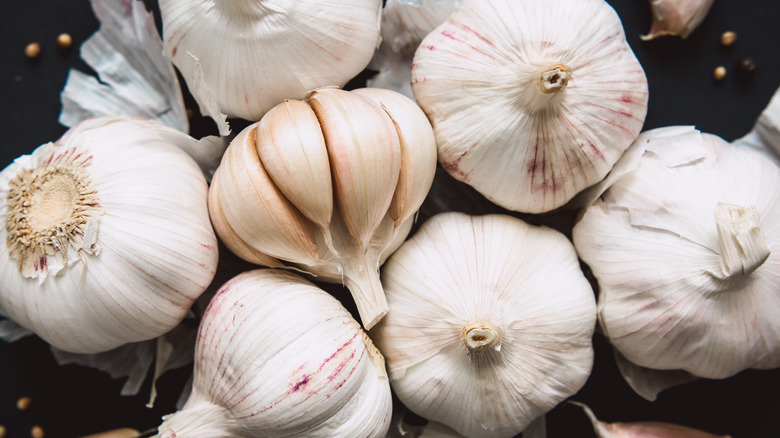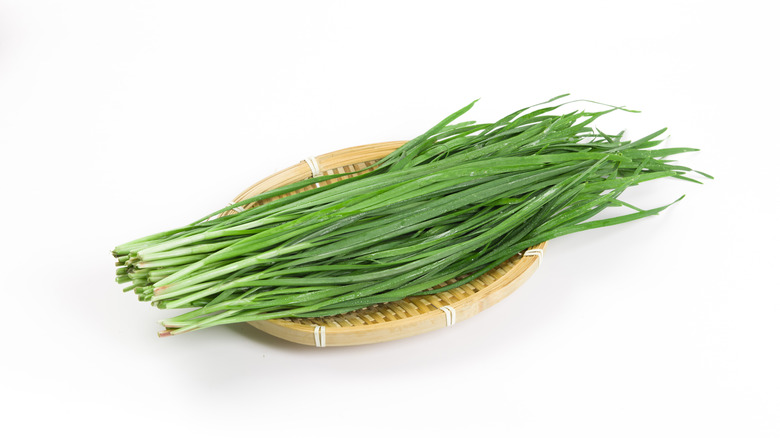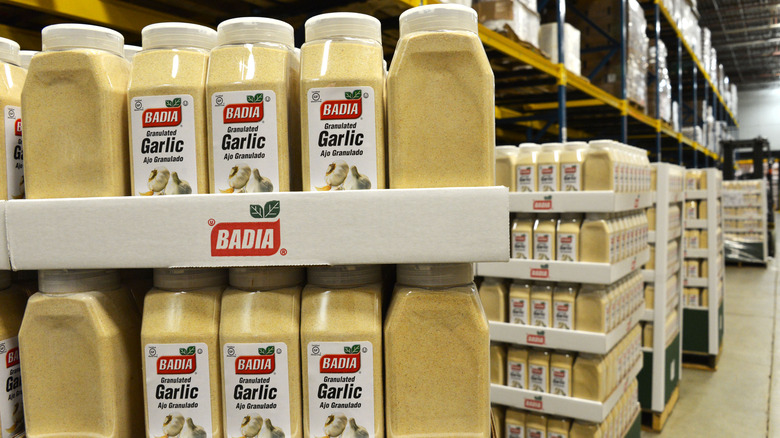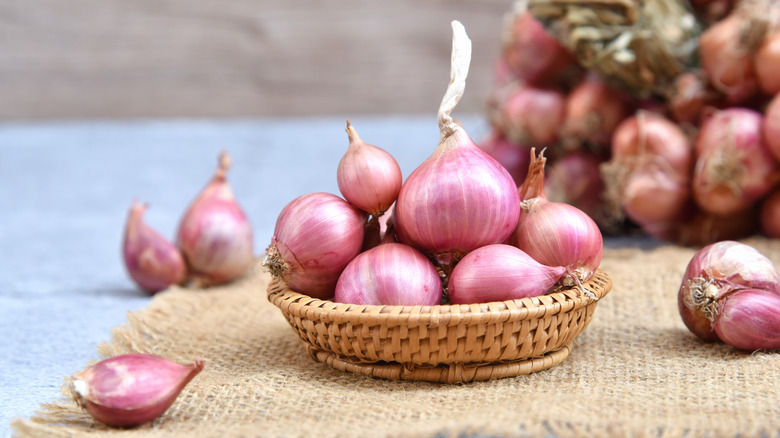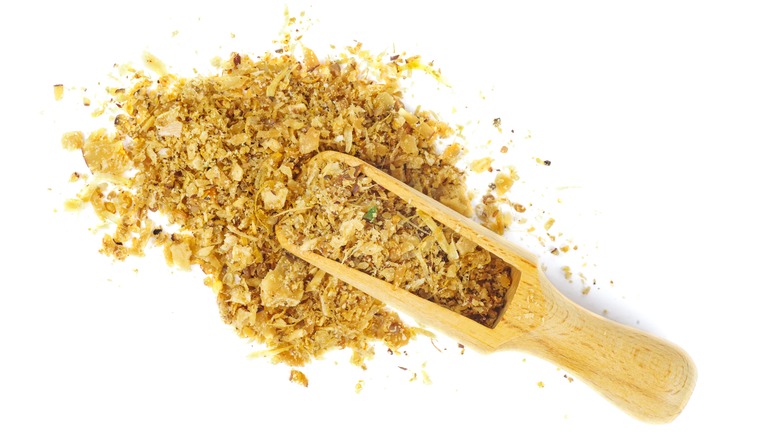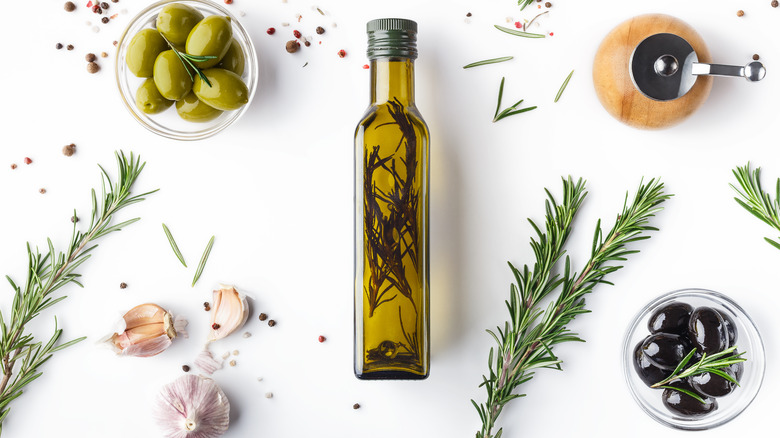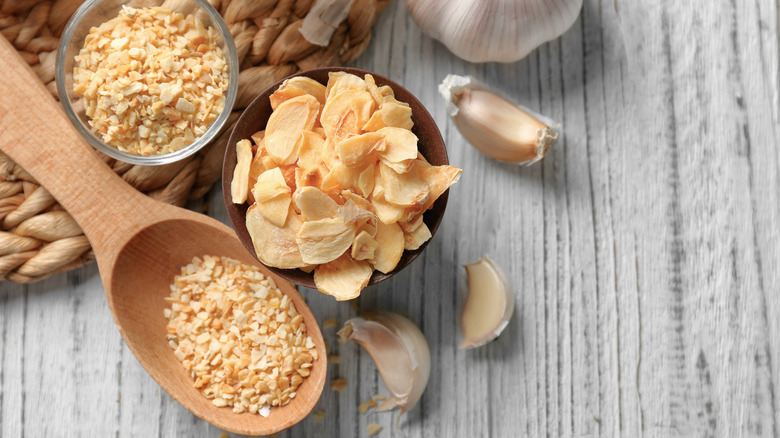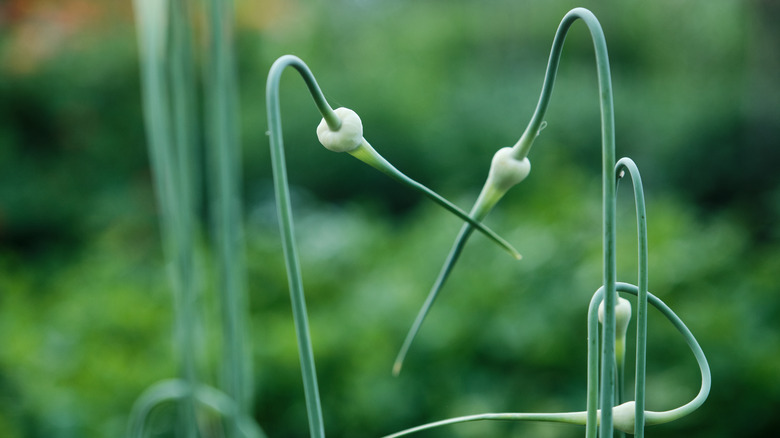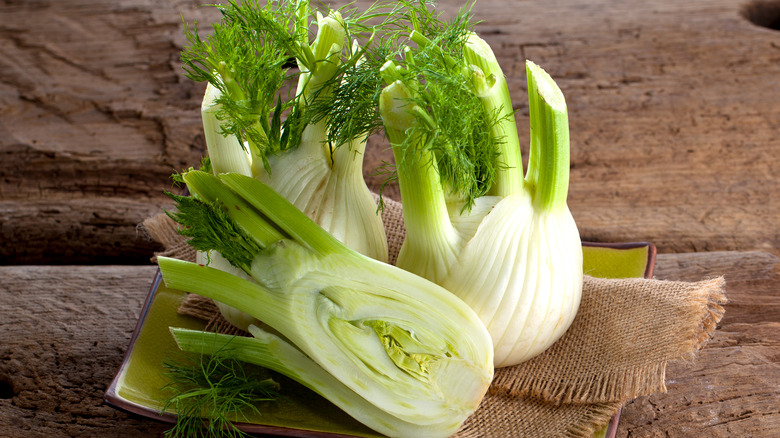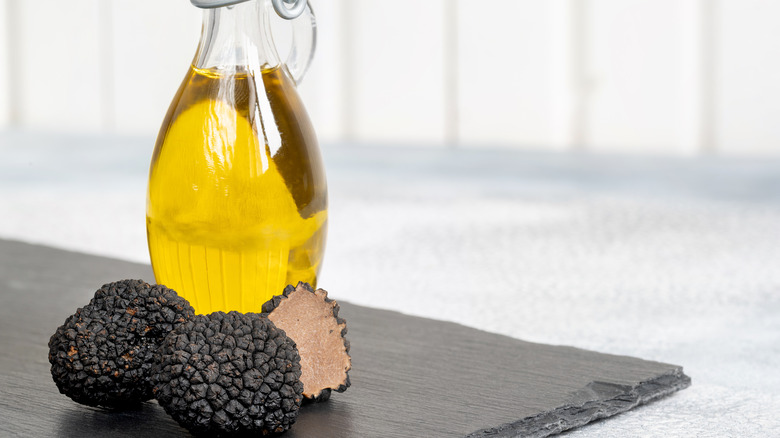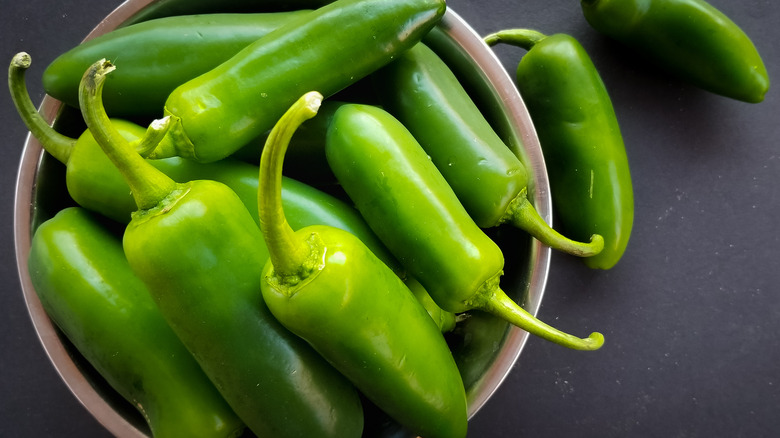10 Garlic Substitutes That Taste Like The Real Thing
It seems like virtually every savory recipe out there calls for using some variation of garlic and onions (sometimes one or the other, but often both). However, you might not always want to use the garlic, or you might have everything you need on hand, except the garlic. What we're getting at is, there are a number of reasons why you might need a garlic substitute when cooking. Some people have food sensitivities, while others can't tolerate the eternal stench of garlic on their hands after mincing it. Sometimes you're just completely out of garlic cloves, and not aware of this fact until you've already commenced making the meal.
In any of those moments, it's good to know you've got several options for garlic substitutes you can employ in a pinch. And while these ingredients won't exactly replicate using fresh garlic, they should pass as a viable swap-in for the popular allium. To help you out, we've created a list of potential garlic substitutes and how to determine which one is the right fit for your cooking needs.
Chives
Chives are in the same plant genus as garlic, so they make a great stand-in for garlic in a pinch (via The Spice House). While regular herb chives that you buy at the grocery store are a suitable substitute, a variety of chives known as garlic chives are an even better option for replacing garlic in a recipe. Per Food 52, garlic chives have a slightly different appearance (the leaves are wider and flatter), as well as other edible components including the blossom, bud, and stem. You can usually find garlic chives at an Asian supermarket, but if not, they're also relatively easy to grow and maintain on your own, according to Say! Little Hen.
Wash, dry, and use kitchen shears to snip the chives to add to the recipe early on when garlic is called for, keeping in mind the garlic chives will have a stronger flavor than standard chives. Garlic chives also become more potent in flavor the longer they're stored in the fridge. Another option would be to sprinkle the minced chives onto the final product, whether it's scrambled eggs or "garlic" bread.
Garlic Powder
Chances are, if you cook a lot, you've got a spice cabinet with some garlic powder in it. This is, obviously, a very easy substitute for actual garlic from a bulb when you're in a jam, or just very opposed to peeling and dealing with fresh garlic for whatever reason.
Wide Open Eats suggest a ratio of ½ teaspoon of garlic powder for every large garlic clove. For a small garlic clove equivalent, ⅛ teaspoon of garlic powder should suffice. To be clear, a garlic clove is the thing you peel (and usually chop to some degree) while a garlic bulb is the cluster of garlic cloves you find in a bin in the produce section.
Just ensure before you pull the trigger that you're working with garlic powder, as opposed to garlic salt or granulated garlic, because those two variations of garlic flavoring might involve different ratios depending on the recipe.
Shallots
Shallots definitely seem like the most garlicky of all the onions when it comes to flavor and scent, so it's no surprise that it is another allium you can utilize in place of garlic. Generally, they are available all year in most grocery stores. They are technically not an actual cross between onions and garlic but some might describe them that way (via Sun Sentinel).
If you do want to use shallots instead of garlic in a recipe, be sure to dice them finely and swap clove for clove. Be careful though, because much like garlic, shallots can get real bitter, real quick if you overcook them. If the recipe calls for onions and garlic, it might be overkill to include the suggested onions and shallots in place of garlic. A tiny dash of minced shallots might be just the right amount of bite to mimic the garlic.
Asafoetida
Once you figure out how to properly pronounce asafoetida (also spelled "asafetida"), it might be a solid consideration for use as a substitute for garlic. While not quite American-mainstream yet, the spice has become a popular alternative on low-FODMAP diets (via Monash University), which temporarily eliminate certain food items (including garlic and onions) that can potentially cause intestinal distress in certain individuals.
According to Nigella, asafoetida is commonly associated with Indian and Middle Eastern cuisine, and also known as "giant fennel" or "hing." It's usually available to buy as a powder online or at specialty (usually Indian) grocers but should be kept well sealed in an airtight container until cooking. The aroma of asafoetida is very pungent (and some might say unappetizing) out of the gate but it does not maintain the strong smell once you start cooking it. Also keep in mind that, per The Spice People, the powdered asafoetida is often created by blending its resin with flour, acacia gum, and starch, so it is technically not gluten-free.
Use it sparingly in place of garlic when cooking. Bon Appétit suggests cooking a pinch directly in a hot pan along with some fat such as butter, oil, or ghee, then allowing it to dissolve for about half a minute before adding any other ingredient to the pan.
Garlic Oil
Garlic oil is essentially olive oil infused with garlic and sometimes other spices. It's made by slow cooking oil with garlic cloves or chopped garlic submerged in it. According to Epicurious, garlic oil is a great option in place of garlic if you want a milder flavor (and less of a raw garlic punch in the mouth) for dressings and marinades. Also, in certain dishes, garlic oil can add just as much flavor drizzled over the final product, without you having to deal with getting the raw stuff all over your fingers in the prepping process.
In a Reddit thread seeking alternatives to garlic, one poster insists garlic oil, whether purchased bottled at the store or concocted in your own kitchen, is "good for people who have problems with garlic" because "you still get the taste, but because fructans aren't fat soluble, none of the bad effects." The fructans in certain foods like garlic are difficult for some people to digest. So garlic oil, added by the teaspoon (to taste) is definitely a good option that can serve as both your oil and your garlic in the recipe if desired.
Granulated Garlic
So there are times when you're out of garlic, and times when you're also out of garlic powder. Then you reach way back into the spice cabinet and discover garlic granules, something you might have bought a while ago for a certain recipe calling for it, then just as quickly forgot about as you proceeded with your normal garlic activities. Garlic granules, not surprisingly, can also be a substitute for fresh garlic.
Granulated garlic and garlic powder are both created from dehydrated garlic but the textures are different. The granules are more coarse than powder, and is the ideal choice when combined with other spices to create spice rubs. According to My Spicer.com, if you're using granulated garlic as a swap for the real deal in a recipe, measure ½ teaspoon of granulated garlic for every clove. Granulated garlic combines really well with liquid so it's an excellent sub-in for dressings, marinades, sauces, and soups.
Garlic Scapes
The chances are, if you don't have garlic lying around the house when you need it, you probably aren't going to have garlic scapes available either. However, if you are purposefully seeking out alternatives to fresh garlic in recipes, garlic scapes might be a promising substitute to research.
Garlic scapes, which are technically both the flower bud and stem of a hardneck garlic plant, are often available at farmers markets in the springtime, and offer a taste that mimics a combo of scallions, onions, and actual garlic. If you can track them down at an Asian supermarket or farmers market when they're in season, they can be used instead of fresh garlic in a recipe.
Per the suggestion of a low-FODMAP (a diet regimen that tends to drastically reduce or eliminate the use of fresh garlic) advocate on Reddit, there are a lot of ways to consume garlic scapes, but to make a garlic paste with the scapes you can "blend then [sic] with olive oil and a pinch of salt, and freeze them in small jars." The same thread even suggests seeking out garlic scape salt if the paste is too strong for certain recipes.
Fennel
A simple vegetable that can be used in place of garlic is fennel, or even dried fennel seeds. With roots in the Mediterranean region, fennel sort of tastes like licorice, and can be consumed raw or cooked, as part of the make-up of your main dish, or on its own as an accompaniment. It can also be used in place of garlic, if you're looking for unique alternatives.
In a thread seeking ways to cook without garlic and onions, one Redditor suggests that because fennel has "the same quality of a forward flavor, you can use the seeds, or get a gentler flavor using the fronds" while another Reddit user warns to use fennel instead of garlic or onion "only for cooked applications. When cooked down the anise flavor dissipates a lot and it's savory." So proceed with caution in terms of amounts and the other ingredients in the meal you're preparing, but definitely consider experimenting with fennel as a substitute for raw garlic in certain recipes.
Truffle Oil
Truffles are considered a magical ingredient in Italy, according to the Italian food experts at Eataly, who also reiterate the importance of knowing the different qualities of the three varieties of truffles. The folks at the upscale Italian grocery chain clarify that not all truffles are alike, and that the ones from the Umbria region of Italy, are the most "garlicky" tasting, hence why when infused with olive oil to make truffle oil, can help to mimic the taste of actual garlic in recipes. (Keep in mind that most truffle oil doesn't actually contain any actual truffles.)
The walls of Reddit confirm the potential for truffle oil as a garlic substitute. In a Reddit thread asking for "go-to onion and garlic substitutes," a user responds, "Truffle salt and truffle oil," and in another one seeking "alternatives to garlic," a different Redditor confirms, "A dash of truffle oil (that way you avoid the whole fructan thing too)." The fructan component of garlic can be hard on digestion for some, which is why many seek garlic alternatives in the first place.
Jalapeño
When you're feeling creative and adventurous, you can always try swapping out minced jalapeño peppers for garlic in a recipe, if you really want to add that kick. Just be sure to substitute sparingly as jalapeños are significantly spicier than raw garlic, but removing the seeds and the veins before cooking helps tone down the heat.
In a post asking for alternatives to garlic, a Redditor responds, "I substitute jalapeños in my hummus when I don't have garlic. It's not a one for one as far as taste goes, of course, but it does the job of adding distinct aroma and flavor." The results may vary depending on exactly what you're preparing and other ingredients but it's possibly to attempt this swap in times of garlic drought in your kitchen (or just a lack of motivation to go to the store and get more garlic).
